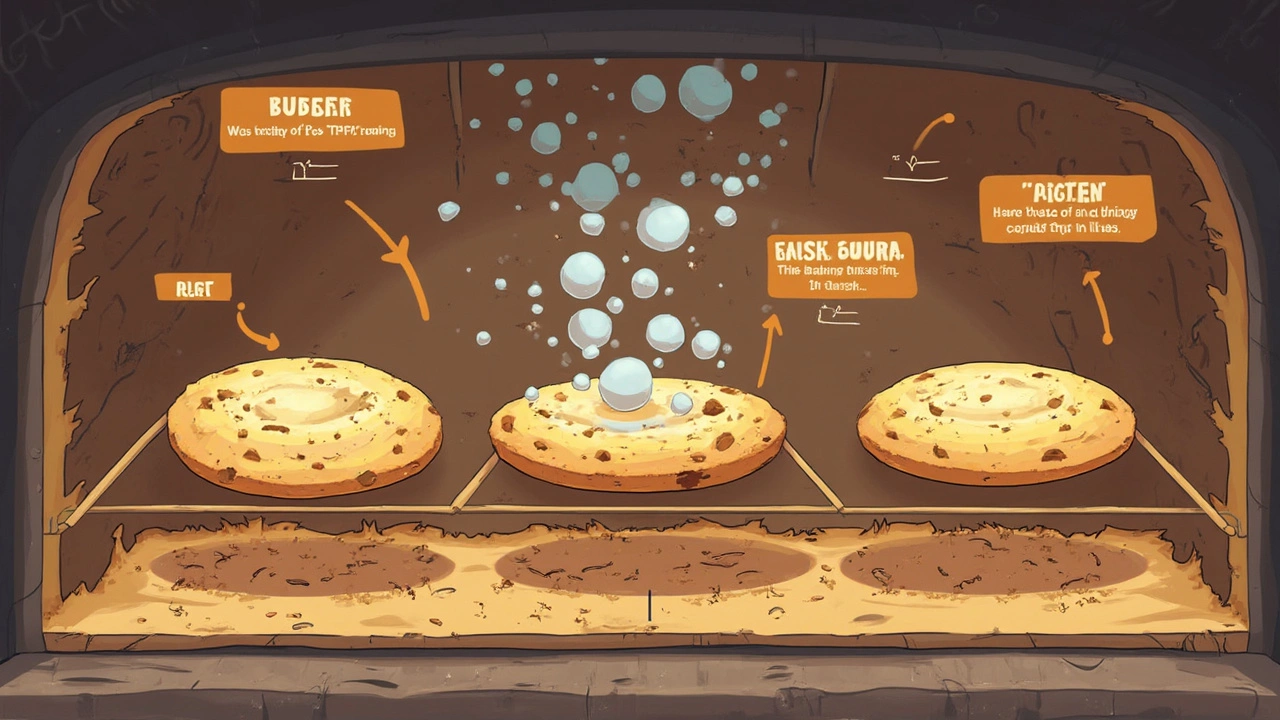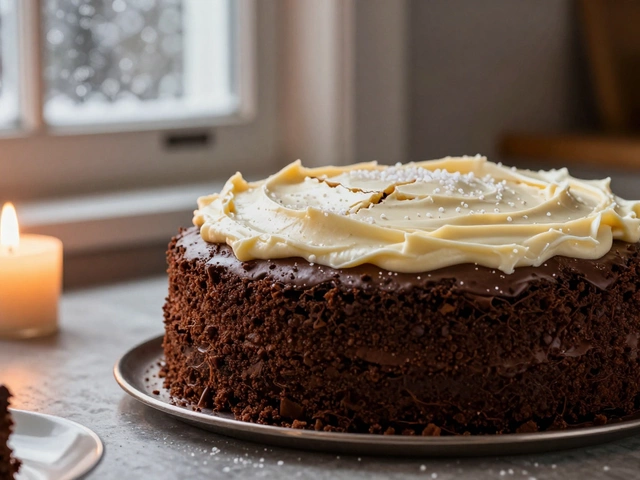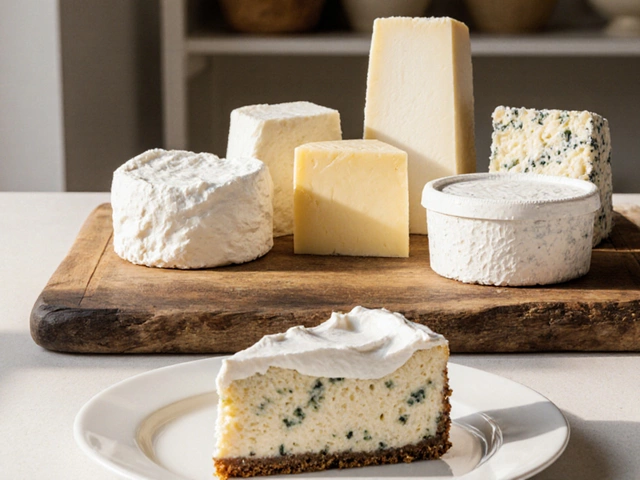Ever pull a tray of cookies from the oven and wonder why some come out thick and pillowy, while others are flat as pancakes? It’s not magic—it’s all about the ingredients and the way they work together.
The secret to a cookie’s rise comes down to a handful of baking basics. Baking soda, baking powder, and even eggs all pull their weight when it comes to making your cookies puff up. Temperature, timing, and even mixing technique play a role, too.
Lots of folks don’t realize that just swapping baking soda for baking powder, or creaming butter a little longer, can totally change how your cookies turn out. Forget guessing—when you know what’s actually happening inside the dough, you can fix flat cookies, or get them just the way you want. Stick around for some bite-sized facts and tricks that’ll give you tall, irresistible cookies every time.
- The Science of Cookie Rise
- The Role of Leavening Agents
- Eggs, Fats, and Sugar: Hidden Helpers
- Troubleshooting Flat Cookies
- Tips for Taller, Chewier Cookies
The Science of Cookie Rise
If you’ve ever mixed up a batch of dough and wondered what actually makes cookies puff up in the oven, you’re not alone. It’s honestly part chemistry experiment and part kitchen magic. When you put dough in a hot oven, a few key things kick off a chain reaction that gives cookies their shape and texture.
The biggest players? Leavening agents. Baking soda and baking powder are the go-to helpers for lift. When the dough heats up, these ingredients release carbon dioxide gas, which forms bubbles that get trapped in the dough. This is what causes cookies to rise instead of staying dense and flat.
But these aren’t working alone. Eggs, especially the whites, hold onto air when you beat them a bit, and that air helps cookies get a lift too. Butter and other fats melt in the oven and create steam, which also helps make cookies puff up instead of spread out flat.
Heat is a game-changer. When the oven is hot enough (usually around 350°F/175°C for most cookie recipes), the outside of your cookie sets quickly, trapping air and steam inside. If your oven runs cool, the cookies might spread too much before setting, and you’ll end up with thin, crispy discs.
Here’s a quick breakdown of the main factors that help cookies rise, so you can see how they stack up:
| Factor | What It Does | Common Mistake |
|---|---|---|
| Baking Soda | Reacts with acid to release CO2 bubbles | Too much = bitter, not enough = flat cookies |
| Baking Powder | Releases CO2 with heat and moisture | Old powder loses strength |
| Eggs | Add structure and trap air | Skipping or too few = flat cookies |
| Butter/Fat | Melts and creates steam for lift | Melted butter = thin cookies |
| Oven Heat | Sets shape and helps gases expand | Low temp = spread before set |
So, if you want those homemade cookies with the perfect rise, pay close attention to what goes into your dough and the temperature of your oven. That’s the real secret behind cookies that look just as good as they taste.
The Role of Leavening Agents
If you want cookies to rise, you need leavening agents. These guys are the difference between a cookie that looks like a hockey puck and one that’s soft, chewy, and thick. Baking soda and baking powder are the two heavy-hitters.
Baking soda is sodium bicarbonate. It reacts with acids like brown sugar, yogurt, or vinegar in your dough. Right when the dough hits the oven’s heat, baking soda starts creating carbon dioxide gas—those tiny bubbles puff up your dough fast. That’s why you see thick, spread-out cookies instead of sad, flat ones. There’s no magic ratio, but most classic cookie recipes need about half a teaspoon of baking soda per cup of flour. Be careful: too much can give a weird soapy taste, and too little means dense cookies.
Baking powder is a mix of baking soda, an acid (usually cream of tartar), and a starch. What's cool? Baking powder works in two stages—when it gets wet, and then again when it gets hot in the oven. So you get a double lift. This is clutch for cookies that need more structure or extra rise, like those cakey sugar cookies. Most recipes use about a teaspoon of baking powder per cup of flour.
Some cookies skip leaveners to keep things fudgy, but for that classic rise, you usually need one or both. Here’s a quick breakdown:
- If your recipe uses only baking soda, make sure there's something acidic in the mix, like brown sugar or honey.
- If it uses just baking powder, no extra acid is required—it’s all built in.
- Some recipes use both for just the right balance of rise and spread.
One last tip: always use fresh leavening agents. Baking soda and powder lose their punch after a few months. If you’re wondering why your cookies came out flat, stale leaveners are often the culprit. Swap in fresh stuff every few months for the best results.

Eggs, Fats, and Sugar: Hidden Helpers
Eggs, fats, and sugar don’t just add flavor to cookies—they help your cookies puff up, spread, or get chewy. Here’s how these everyday ingredients actually work inside your dough.
Eggs are the behind-the-scenes powerhouses in your cookie recipe. The whites help hold things together, kind of like glue, while the yolks add richness and moisture. More eggs usually mean softer and thicker cookies. Less, and you might get a thinner, crispier result. One large egg adds about 3.25 tablespoons of liquid, which helps your cookies steam and puff up as they bake.
Fats come in different forms—think butter, shortening, or even oils. Butter is the classic pick because it’s got water and milk solids in it. When butter melts in the oven, that little bit of water turns to steam and puffs up your cookies. But here’s a trick: if you use melted butter, your cookies will usually spread more and come out chewier. Chilled butter helps them stay thick and rise higher. If you’re after a super soft batch, you can try using shortening because it keeps cookies from spreading too much.
Sugar does way more than just sweeten things up. It locks in moisture, helps the cookies brown, and even helps with rise. Creaming butter and sugar together adds tiny air bubbles to the mix, which puff up as your cookies bake. More sugar usually means more spread, so if you want a thick cookie, try cutting back a bit. For a deeper flavor and chewier texture, swap out some white sugar for brown sugar—it’s got molasses in it, which bumps up the moisture.
Here’s a quote from Shirley Corriher, a well-known food scientist and cookbook author:
“Both sugar and fat tenderize cookies by cutting flour’s gluten, and eggs bring everything together for the perfect structure.”
Check out how these ingredients stack up in different cookies:
| Cookie Type | Eggs | Fat | Sugar |
|---|---|---|---|
| Classic Chocolate Chip | 1 large | Butter | White & Brown |
| Crispy Sugar Cookie | 1 medium | Butter | Mostly White |
| Chewy Oatmeal | 2 large | Shortening | Mostly Brown |
Try this simple tweak: if your cookies are coming out too flat, chill the dough about 30 minutes before baking, or cream your butter and sugar longer. That extra air gets you a taller cookie, every time.
Troubleshooting Flat Cookies
Nothing kills the cookie vibe like a batch that turns out thin and flat. Before you start blaming your oven, check out these common reasons and how to fix them. This is all about getting your cookies to rise up, not spread out.
Here are some usual suspects that make cookies go flat:
- Butter too warm or melted: If your butter is too soft or even melted before mixing, the dough will spread fast in the oven. Use room temperature butter that’s just soft enough to press with your finger but not greasy.
- Not enough flour: Skimping on flour gives you thin cookies that spread like wildfire. Be sure to measure flour the right way—scoop gently and level the top.
- Old baking soda or baking powder: These lose their power over time. If yours are older than six months, it’s time to restock. Flat cookies are often a sign your leaveners have lost their oomph.
- Overmixing the dough: Mixing too hard or too long whips out the air and breaks down the dough, making cookies dense and flat.
- Sheet too warm: Dropping dough on a hot baking sheet means cookies start to melt before they ever bake. Always cool or use fresh sheets for every batch.
For more perspective, check out the comparison in the table below. It shows what happens when key cookie-making variables go wrong.
| Problem | Impact on Cookie | Quick Fix |
|---|---|---|
| Butter melted | Cookies spread too much, come out flat | Use room temp, not melted butter |
| Not enough flour | Thin, greasy cookies | Measure flour accurately |
| Old baking soda/powder | No lift, cookies stay flat | Buy new leaveners every 6 months |
| Hot baking sheet | Dough spreads fast | Cool sheet or use a new one |
| Overmixed dough | Dense and flat texture | Mix just until combined |
If you follow these pointers and still get flat cookies, try chilling your dough for 30 minutes before baking. Chilled dough spreads less, giving cookies time to rise before the heat melts everything down. Tiny adjustments make a big difference, and it really just takes a keen eye and a bit of patience to crack the code.

Tips for Taller, Chewier Cookies
If you want your cookies to stand tall and stay chewy, a few simple tweaks make all the difference. Here’s how home bakers consistently get those bakery-style results—no fancy gear required.
- Chill your dough. Cold dough means less spreading in the oven. Pop the mixed dough in the fridge for 30 minutes to an hour. That bit of patience pays off with chunkier, chewier cookies.
- Adjust your flour. If your cookies are spreading too much, measure your flour carefully. Even a couple of extra tablespoons can help the cookies hold shape. But don’t go overboard or you’ll get cakey cookies.
- Use brown sugar. It’s all about moisture. Brown sugar has more moisture than white sugar, and a touch of molasses. That means a chewier texture every time.
- Don’t overmix. Once you add flour, mix just until everything’s combined. Overmixing builds gluten, leaving you with tough cookies instead of chewy ones.
- Try bread flour for a change. Swapping in bread flour for some/all-purpose flour adds protein, which helps give chew without making the cookies tough.
- Watch your baking time. If you love soft, chewy cookies, pull them from the oven just as the edges are set but the centers look a touch underdone. They’ll finish cooking on the baking sheet.
- Keep an eye on butter temperature. Soft (but not melted) butter helps trap more air when creamed with sugar, leading to thicker cookies.
Temperature and ingredient choices have a bigger impact than you might think. For example, just 10°F—about 5°C—difference in your oven changes cookie height and chew a lot.
| Problem | Try This |
|---|---|
| Flat cookies | Chill dough, add more flour, check baking soda freshness |
| Dry cookies | Use more brown sugar, slightly underbake, avoid overmixing |
| Bland texture | Swap in bread flour, cream butter and sugar longer |
If you want bakery-style cookies at home, the biggest hack is to take notes on what works in your kitchen. Your oven, your flour, even your local humidity can nudge your cookies to spread or stand up. Keep a notepad or your phone near and track what batches turn out best—soon, you’ll have a go-to method for the chewiest, tallest cookies every time.





